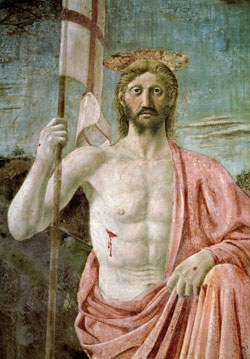Christ is truly risen!
He really died, he was not a hallucination and the Apostles didn’t make up the story

The risen Christ is depicted in this detail from the “Resurrection” by Italian Renaissance master Piero della Francesca. Easter, the feast of the Resurrection, is April 4 in the Latin rite this year. (CNS photo/Erich Lessing,Art Resource)
By John F. Fink
The Lord is risen! Yes, he is risen indeed!
That’s the truth we Christians profess on Easter.
Jesus—after dying the cruel death by crucifixion, being wrapped in a shroud and buried, and while his tomb was being guarded by soldiers—rose from the dead.
He then appeared to Mary Magdalene and other women, to the Apostles, to disciples on the road, and to 500 people at one time.
It would seem preposterous to deny the Resurrection with all the evidence in favor of it.
Nevertheless, there are people who still don’t believe it actually happened. In fact, they think it is preposterous to believe that such a thing could possibly happen.
Why? Because it’s not possible for someone who is actually dead to come back to life.
People in the 21st century know that it can’t happen. Well, people living in the first century knew that, too. That’s why Jesus’ resurrection is so remarkable—indeed, miraculous.
But maybe Jesus didn’t actually die. Maybe he only appeared to be dead. That means that he awoke in the tomb in a severely weakened condition, somehow was able to get out of the shroud that bound him, had the strength to push back the boulder in front of the tomb without the soldiers noticing it, and then made his appearances as a healthy man!
Well, what about that story the soldiers were instructed to tell—that Jesus’ disciples stole his body while the soldiers were asleep (Mt 28:11-15)?
How plausible is that? Can you imagine what would have happened to the soldiers if they had, indeed, fallen asleep?
Even if they had, wouldn’t they have been awakened by the scraping of the boulder as it was being pushed away from the entrance?
The story that the chief priests and the elders instructed the soldiers to tell only reinforces the evidence that the tomb was empty.
Maybe the Apostles only thought that Jesus appeared to them, and it was all a hallucination. However, they all had the same hallucination and that hallucination kept reoccurring for 40 days.
The fact is that Jesus felt that he had to prove to the Apostles that he wasn’t a ghost by telling them to touch him and by eating some food (Lk 24:36-43), and by telling Thomas to examine his body (Jn 20:27).
Author C. S. Lewis wrote in his book Miracles that any theory of hallucination breaks down on the fact that on three separate occasions this hallucination was not immediately recognized as Jesus (Lk 24:13-31; Jn 20:15; 21:4).
Lewis wrote, “Might we not at least hope that he would get the face of the hallucination right? Is he who made all faces such a bungler that he cannot even work up a recognizable likeness of the man who was himself?”
Of course, hallucination theories explain only Jesus’ appearances after his resurrection. They don’t explain the empty tomb, the rolled-away boulder or the fact that nobody could produce the corpse.
There’s still the possibility that the Apostles made up the whole story—the least likely theory, it would seem, since all that the Jewish and Roman authorities would have had to do was produce Jesus’ body to refute it.
The fact that the Apostles refused to believe the report of the women to whom Jesus first appeared contradicts the theory that the Apostles made it up.
Thomas wasn’t the only Apostle to doubt the Resurrection—all the Apostles did until Jesus appeared to them: “Their story seemed like nonsense and they did not believe them” (Lk 24:11).
If we were to believe that the Apostles made up the story, we would have to discount the accounts in the Gospels. We would have to believe that, after Jesus’ death, the Apostles got together and plotted how they could deceive everyone.
Somehow they would have had to get Jesus’ body where it was buried and hide it. Then they could claim that he had been raised from the dead and appeared to them. Then they could fan out and preach about Jesus, even while knowing that doing so could mean that they would be killed as Jesus was.
From what we know about the Apostles—fishermen, a tax collector and other simple men—can we really believe that they could do what they did while knowing that it was all a lie?
When it came down to their martyrdom, wouldn’t at least one of them admit that they had made it up?
Quite the contrary. They preached Jesus as risen from the dead because they knew full well that it was true.
St. Paul, to whom the resurrected Jesus appeared, told the Corinthians, “If Christ has not been raised, your faith is vain. … But Christ has been raised from the dead” (1 Cor 15:17, 20). He knew it was a fact, and so do we.
That’s why we can confidently proclaim, “Christ is risen! Yes, he is truly risen!”
(John F. Fink is the editor emeritus of The Criterion.) †
